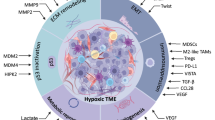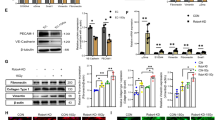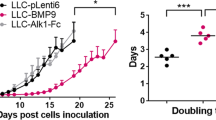Abstract
Gene electrotransfer of plasmid encoding shRNA against endoglin exerts antitumor efficacy, predominantly by vascular targeted effect. As vascular targeting therapies can promote radiosensitization, the aim of this study was to explore this gene therapy approach with single and split dose of irradiation in an endoglin non-expressing TS/A mammary adenocarcinoma tumor model to specifically study the vascular effects. Intratumoral gene electrotransfer of plasmids encoding shRNA against endoglin, under the control of a constitutive or tissue-specific promoter for endothelial cells, combined with a single or three split doses of irradiations was evaluated for the antitumor efficacy and histologically. Both plasmids proved to be equally effective in tumor radiosensitization with 40–47% of tumor cures. The combined treatment induced a significant decrease in the number of blood vessels and proliferating cells, and an increase in levels of necrosis, apoptosis and hypoxia; therefore, the antitumor efficacy was ascribed to the interaction of vascular targeted effect of gene therapy with irradiation. Endoglin silencing by the shRNA technology, combined with electrotransfer and the use of a tissue-specific promoter for endothelial cells, proved to be a feasible and effective therapeutic approach that can be used in combined treatment with tumor irradiation.
This is a preview of subscription content, access via your institution
Access options
Subscribe to this journal
Receive 12 print issues and online access
$259.00 per year
only $21.58 per issue
Buy this article
- Purchase on Springer Link
- Instant access to full article PDF
Prices may be subject to local taxes which are calculated during checkout





Similar content being viewed by others
References
Clemenson C, Chargari C, Deutsch E . Combination of vascular disrupting agents and ionizing radiation. Crit Rev Oncol Hematol 2013; 86: 143–160.
El Kaffas A, Tran W, Czarnota GJ . Vascular strategies for enhancing tumour response to radiation therapy. Technol Cancer Res Treat 2012; 11: 421–432.
Mazeron R, Anderson B, Supiot S, Paris F, Deutsch E . Current state of knowledge regarding the use of antiangiogenic agents with radiation therapy. Cancer Treat Rev 2011; 37: 476–486.
Xu Z, Dong Y, Peng F, Yu Z, Zuo Y, Dai Z et al. Pigment epithelium-derived factor enhances tumor response to radiation through vasculature normalization in allografted lung cancer in mice. Cancer Gene Ther 2015; 22: 181–187.
Ciric E, Sersa G . Radiotherapy in combination with vascular-targeted therapies. Radiol Oncol 2010; 44: 67–78.
Crokart N, Danhier F, Daugimont L, Goncalves N, Jordan BF, Gregoire V et al. Potentiation of radiotherapy by a localized antiangiogenic gene therapy. Radiother Oncol 2013; 107: 252–258.
Morris ZS, Harari PM . Interaction of radiation therapy with molecular targeted agents. J Clin Oncol 2014; 32: 2886–2893.
Rosen LS, Gordon MS, Robert F, Matei DE . Endoglin for targeted cancer treatment. Curr Oncol Rep 2014; 16: 365.
Munoz R, Arias Y, Ferreras JM, Jimenez P, Langa C, Rojo MA et al. In vitro and in vivo effects of an anti-mouse endoglin (CD105)-immunotoxin on the early stages of mouse B16MEL4A5 melanoma tumours. Cancer Immunol Immunother 2013; 62: 541–551.
Tsujie M, Tsujie T, Toi H, Uneda S, Shiozaki K, Tsai H et al. Anti-tumor activity of an anti-endoglin monoclonal antibody is enhanced in immunocompetent mice. Int J Cancer 2008; 122: 2266–2273.
Uneda S, Toi H, Tsujie T, Tsujie M, Harada N, Tsai H et al. Anti-endoglin monoclonal antibodies are effective for suppressing metastasis and the primary tumors by targeting tumor vasculature. Int J Cancer 2009; 125: 1446–1453.
Dolinsek T, Markelc B, Sersa G, Coer A, Stimac M, Lavrencak J et al. Multiple delivery of siRNA against endoglin into murine mammary adenocarcinoma prevents angiogenesis and delays tumor growth. PLos One 2013; 8: e587.
Dolinsek T, Markelc B, Bosnjak M, Blagus T, Prosen L, Kranjc S et al. Endoglin silencing has significant antitumor effect on murine mammary adenocarcinoma mediated by vascular targeted effect. Curr Gene Ther 2015; 15: 228–244.
Stimac M, Dolinsek T, Lampreht U, Cemazar M, Sersa G . Gene electrotransfer of plasmid with tissue specific promoter encoding shRNA against endoglin exerts antitumor efficacy against murine TS/A tumors by vascular targeted effects. PLos One 2015; 10: e0124913.
Tesic N, Kamensek U, Sersa G, Kranjc S, Stimac M . Endoglin (CD105) silencing mediated by shRNA under the control of endothelin-1 promoter for targeted gene therapy of melanoma. Mol Ther Nucleic Acids 2015; 4: e239.
Dolinsek T, Sersa G, Prosen L, Bosnjak M, Stimac M, Razborsek U et al. Electrotransfer of plasmid DNA encoding an anti-mouse endoglin (CD105) shRNA to B16 melanoma tumors with low and high metastatic potential results in pronounced anti-tumor effects. Cancers 2016; 8: 3.
Cemazar M, Todorovic V, Scancar J, Lampreht U, Stimac M, Kamensek U et al. Adjuvant TNF-alpha therapy to electrochemotherapy with intravenous cisplatin in murine sarcoma exerts synergistic antitumor effectiveness. Radiol Oncol 2015; 49: 32–40.
Daud AI, DeConti RC, Andrews S, Urbas P, Riker AI, Sondak VK et al. Phase I trial of interleukin-12 plasmid electroporation in patients with metastatic melanoma. J Clin Oncol 2008; 26: 5896–5903.
Sardesai NY, Weiner DB . Electroporation delivery of DNA vaccines: prospects for success. Curr Opin Immunol 2011; 23: 421–429.
Heller R, Heller LC . Gene electrotransfer clinical trials. Adv Genet 2015; 89: 235–262.
Spanggaard I, Snoj M, Cavalcanti A, Bouquet C, Sersa G, Robert C et al. Gene electrotransfer of plasmid antiangiogenic metargidin peptide (AMEP) in disseminated melanoma: safety and efficacy results of a phase I first-in-man study. Hum Gene Ther Clin Dev 2013; 24: 99–107.
Vidic S, Markelc B, Sersa G, Coer A, Kamensek U, Tevz G et al. MicroRNAs targeting mutant K-ras by electrotransfer inhibit human colorectal adenocarcinoma cell growth in vitro and in vivo. Cancer Gene Ther 2010; 17: 409–419.
Cemazar M, Sersa G, Wilson J, Tozer GM, Hart SL, Grosel et al. Effective gene transfer to solid tumors using different nonviral gene delivery techniques: electroporation, liposomes, and integrin-targeted vector. Cancer Gene Ther 2002; 9: 399–406.
Papadakis ED, Nicklin SA, Baker AH, White SJ . Promoters and control elements: designing expression cassettes for gene therapy. Curr Gene Ther 2004; 4: 89–113.
Tesic N, Cemazar M . In vitro targeted gene electrotransfer to endothelial cells with plasmid DNA containing human endothelin-1 promoter. J Membr Biol 2013; 246: 783–791.
Nanni P, de Giovanni C, Lollini PL, Nicoletti G, Prodi G . TS/A: a new metastasizing cell line from a BALB/c spontaneous mammary adenocarcinoma. Clin Exp Metastasis 1983; 1: 373–380.
Kranjc S, Cemazar M, Grosel A, Scancar J, Sersa G . Electroporation of LPB sarcoma cells in vitro and tumors in vivo increases the radiosensitizing effect of cisplatin. Anticancer Res 2003; 23: 275–281.
Sedlar A, Kranjc S, Dolinsek T, Cemazar M, Coer A, Sersa G . Radiosensitizing effect of intratumoral interleukin-12 gene electrotransfer in murine sarcoma. BMC Cancer 2013; 13: 38.
André FM, Cournil-Henrionnet C, Vernerey D, Opolon P, Mir LM . Variability of naked DNA expression after direct local injection: the influence of the injection speed. Gene Ther 2006; 13: 1619–1627.
Kamensek U, Sersa G, Cemazar M . Evaluation of p21 promoter for interleukin 12 radiation induced transcriptional targeting in a mouse tumor model. Mol Cancer 2013; 12: 136.
Tomayko MM, Reynolds CP . Determination of subcutaneous tumor size in athymic (nude) mice. Cancer Chemother Pharmacol 1989; 24: 148–154.
Kranjc S, Tevz G, Kamensek U, Vidic S, Cemazar M, Sersa G . Radiosensitizing effect of electrochemotherapy in a fractionated radiation regimen in radiosensitive murine sarcoma and radioresistant adenocarcinoma tumor model. Radiat Res 2009; 172: 677–685.
Spector SA, Tyndall M, Kelley E . Effects of acyclovir combined with other antiviral agents on human cytomegalovirus. Am J Med 1982; 73: 36–39.
Gacche RN . Compensatory angiogenesis and tumor refractoriness. Oncogenesis 2015; 4: e153.
Huang Y, Carbone DP . Mechanisms of and strategies for overcoming resistance to anti-vascular endothelial growth factor therapy in non-small cell lung cancer. Biochim Biophys Acta 2015; 1855: 193–201.
Bergers G, Hanahan D . Modes of resistance to anti-angiogenic therapy. Nat Rev Cancer 2008; 8: 592–603.
Ebos JM, Lee CR, Kerbel RS . Tumor and host-mediated pathways of resistance and disease progression in response to antiangiogenic therapy. Clin Cancer Res 2009; 15: 5020–5025.
Fonsatti E, Nicolay HJM, Altomonte M, Covre A, Maio M . Targeting cancer vasculature via endoglin/CD105: a novel antibody-based diagnostic and therapeutic strategy in solid tumours. Cardiovasc Res 2010; 86: 12–19.
Tevz G, Kranjc S, Cemazar M, Kamensek U, Coer A, Krzan M et al. Controlled systemic release of interleukin-12 after gene electrotransfer to muscle for cancer gene therapy alone or in combination with ionizing radiation in murine sarcomas. J Gene Med 2009; 11: 1125–1137.
Bonnafous P, Vernhes M, Teissie J, Gabriel B . The generation of reactive-oxygen species associated with long-lasting pulse-induced electropermeabilisation of mammalian cells is based on a non-destructive alteration of the plasma membrane. Biochim Biophys Acta 1999; 1461: 123–134.
Sersa G, Kranjc S, Cemazar M . Improvement of combined modality therapy with cisplatin and radiation using electroporation of tumors. Int J Radiat Oncol Biol Phys 2000; 46: 1037–1041.
Acknowledgements
We acknowledge M Lavric for her help with cell cultures and tumor transplantation, A Prevc and K Znidar for help with histology, T Dolinsek for help with endoglin silencing experiments and V Todorovic for useful tips. The research was supported by Slovenian Research Agency (P3-0003, J3-4211, J3-6793) and conducted in the scope of LEA EBAM (French-Slovenian European Associated Laboratory: Pulsed Electric Fields Applications in Biology and Medicine) and is a result of networking efforts within the COST TD1104 Action.
Author information
Authors and Affiliations
Corresponding author
Ethics declarations
Competing interests
The authors declare no conflict of interest.
Additional information
Supplementary Information accompanies the paper on Cancer Gene Therapy website
Supplementary information
Rights and permissions
About this article
Cite this article
Stimac, M., Kamensek, U., Cemazar, M. et al. Tumor radiosensitization by gene therapy against endoglin. Cancer Gene Ther 23, 214–220 (2016). https://doi.org/10.1038/cgt.2016.20
Received:
Revised:
Accepted:
Published:
Issue Date:
DOI: https://doi.org/10.1038/cgt.2016.20



